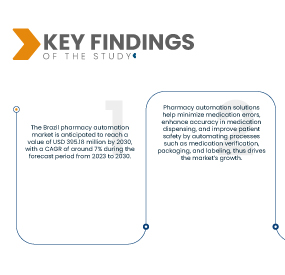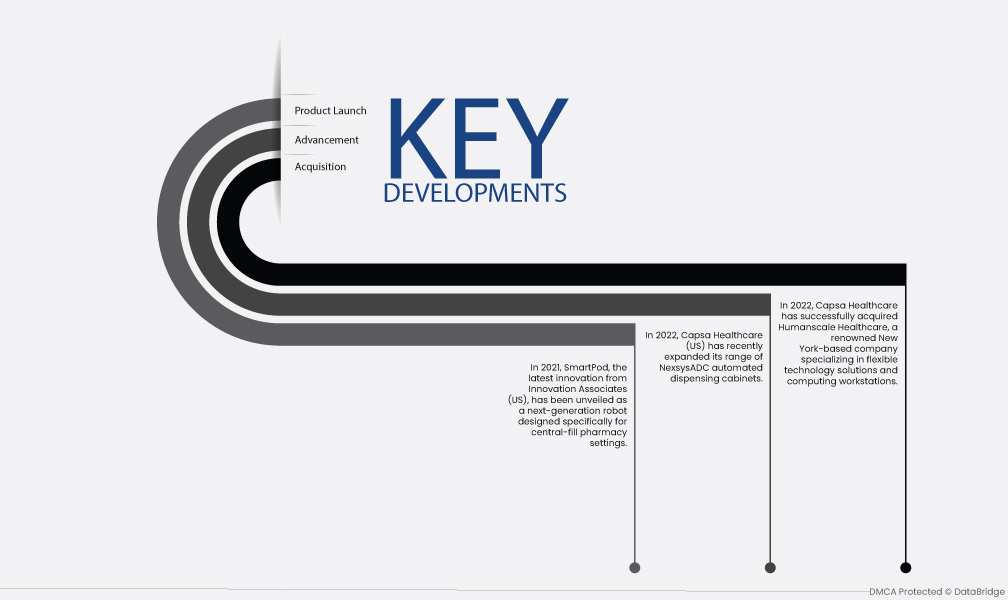Pharmacy automation offers a range of applications, features, and uses in the healthcare industry. It includes automated medication dispensing systems, robotic prescription fulfillment, inventory management, medication verification, and packaging solutions. These technologies streamline pharmacy operations, improve medication safety, enhance inventory control, and optimize workflow efficiency. Pharmacy automation reduces the risk of errors, enhances patient care, and increases operational productivity. It is utilized in various settings, such as hospitals, retail pharmacies, long-term care facilities, and specialty pharmacies, to deliver accurate and efficient medication management solutions.
Access Full Report: https://databridgemarketresearch.com/reports/brazil-pharmacy-automation-market
Data Bridge Market Research analyses that the Brazil Pharmacy Automation Market is valued at USD 230 million in 2022 and is expected to reach USD 395.18 million by 2030, registering a CAGR of 7% during the forecast period of 2023 to 2030. With the rising demand for healthcare services, including medication dispensing and prescription management, pharmacy automation streamlines workflows, reduces manual labor, and improves operational efficiency, enabling pharmacies to handle higher volumes of prescriptions effectively.
Key Findings of the Study
Advancement in technology is expected to drive the market's growth rate
The integration of advanced technologies like robotics, AI, machine learning, and data analytics in pharmacy automation systems brings significant benefits to medication management, inventory control, and workflow optimization. These technologies enable automated medication dispensing, precise inventory tracking, and real-time data analysis for better decision-making. Leveraging AI and machine learning algorithms, pharmacies can identify trends, predict medication needs, and optimize stock levels. Robotics can handle repetitive tasks with high accuracy, reducing errors and freeing up pharmacists' time for more critical patient care.
Report Scope and Market Segmentation
|
Report Metric
|
Details
|
|
Forecast Period
|
2023 to 2030
|
|
Base Year
|
2022
|
|
Historic Years
|
2021 (Customizable to 2015-2020)
|
|
Quantitative Units
|
Revenue in USD Million, Volumes in Units, Pricing in USD
|
|
Segments Covered
|
Product (Automated Medication Dispensing Systems, Automated Packaging and Labeling Systems, Automated Table-Top Counters, Automated Storage and Retrieval Systems, Other Pharmacy Automation Systems), End User (Inpatient Pharmacies, Outpatient Pharmacies, Pharmacy Benefit Management Organization and Mail Order Pharmacies, Retail Pharmacies)
|
|
Market Players Covered
|
Talyst, LLC. (U.S.), OMNICELL, INC. (U.S.), Cerner Corporation (U.S.), Capsa Healthcare (U.S.), Parata Systems, LLC (U.S.), RxSafe, LLC. (U.S.), RxMedic Systems, Inc. (U.S.), MedAvail Technologies, Inc. (Canada), Asteres Inc. (U.S.), PerceptiMed, Inc. (U.S.), BD (U.S.), Baxter (U.S.), Fullscript (Canada), McKesson Corporation (U.S.), AmerisourceBergen Corporation (U.S.), vitabook GmbH (Germany), TOSHO co. (Japan), Gebr. Willach GmbH (Germany), Grifols, S.A. (Spain)
|
|
Data Points Covered in the Report
|
In addition to the insights on market scenarios such as market value, growth rate, segmentation, geographical coverage, and major players, the market reports curated by the Data Bridge Market Research also include depth expert analysis, patient epidemiology, pipeline analysis, pricing analysis, and regulatory framework
|
Segment Analysis:
The pharmacy automation market is segmented on the basis of product and end user.
- On the basis of product the market is segmented into automated medication dispensing systems, automated packaging and labeling systems, automated table-top counters, automated storage and retrieval systems, other pharmacy automation systems.
- On the basis of end user the market is segmented into Inpatient pharmacies, outpatient pharmacies, pharmacy benefit management organization and mail order pharmacies, retail pharmacies.
Major Players
Data Bridge Market Research recognizes the following companies as the major pharmacy automation market players in pharmacy automation market are Talyst, LLC. (U.S.), OMNICELL, INC. (U.S.), Cerner Corporation (U.S.), Capsa Healthcare (U.S.), Parata Systems, LLC (U.S.), RxSafe, LLC. (U.S.), RxMedic Systems, Inc. (U.S.)
Market Development
- In 2022, Capsa Healthcare has successfully acquired Humanscale Healthcare, a renowned New York-based company specializing in flexible technology solutions and computing workstations. This acquisition strengthens Capsa's position in the market by broadening its product portfolio and enhancing its capability to deliver ergonomically designed point-of-care computing solutions to healthcare partners globally.
- In 2022, Capsa Healthcare (US) has recently expanded its range of NexsysADC automated dispensing cabinets. The expansion includes the introduction of two new sizes of Controlled Access Module Drawers, allowing NexsysADC to effectively accommodate controlled or high-value medications and supplies of any size.
- In 2021, SmartPod, the latest innovation from Innovation Associates (US), has been unveiled as a next-generation robot designed specifically for central-fill pharmacy settings. With SmartPod, providers gain the flexibility to customize and expand their centralized fulfillment solutions according to the demands of their operations.
For more detailed information about the pharmacy automation market report, click here – https://www.databridgemarketresearch.com/ar/reports/brazil-pharmacy-automation-market














